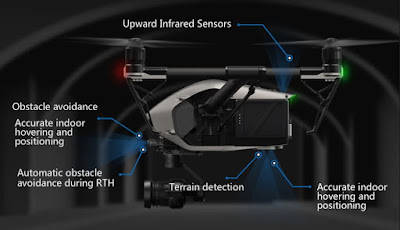This report
will discuss the data protocol and format for the DJI Inspire 2 unmanned aerial
system (UAS). This small multirotor is
setting the standard for professional grade filming from a stable UAS
platform. The system is equipped with
multiple sensors which are used specifically for flying the vehicle and
avoiding obstacles (DJI, 2017). These sensors include a downward vision
system, upward infrared (IR) sensor, and a forward vision system. Each of these are used to alert the operator
or flight management computer of an impending obstacle allowing the system to
put in the needed control inputs (DJI, 2017). The data from these sensors has no need to be
stored as it is used by the vehicle immediately upon reception. Recalling the data is not something the
designers thought the Inspire 2 needed.
Figure 1. Inspire 2 Obstacle Avoidance Sensors (DJI, 2017)
There is a
sensor on-board the Inspire 2 which produces the data the operators are very
concerned with recalling. That would be
the video data from the gimbal mounted camera mounted on the underbelly of the vehicle. There are multiple camera options for the
Inspire 2, but this work is going to focus on the absolute best camera the
vehicle can handle. That would be the
Zenmuse X5S (DJI, 2017). The camera is able to be equipped with any
Micro 4/3 lenses, can take quality video up to 5.2K at 30FPS, 20.8 MP still
pictures, and even a 20 FPS continuous burst (DJI, 2017).
Figure 2. Inspire 2 Equipped with X5S Camera (DJI, 2017)
All of this is amazing, but useless unless the data is
stored efficiently and in a format useful to professional filmmakers. The Inspire is equipped to store video data
in CinemaDNG and Apple ProRes 5.2K with H.265 and H.264 codec support (DJI, 2017). The recorded video is stored using a
FAT32/exFAT file system simultaneously on a DJI CINESSD or a Micro-SD
card. A DJI CINESSD is a DJI designed
storage media using NVMe logical device interface. The card comes in 120 and 480 GB capacities. The
still shots are stored using a standard JPEG/DNG/JPEG+DNG formats. All of these formats make the processing of
such data simpler.
Figure 3. Inspire 2 Sensor Data Protocol (DJI, 2017)
The Inspire
2 is already an amazing piece of unmanned technology. There are not many features which an operator
could ask for which the Inspire 2 does not already have. With all the pros in flight management,
sensor ability, and data treatment there is only one con which I have for the
system as a whole. That would be the
on-board storage devices in the Micro SSD or the DJI CINESSD. I understand that both of these components
were chosen/designed for the specific reason of size and functionality,
however, I believe the Micro SSD is too small to be tracked easily. That is simply this author’s opinion, but all
of the other systems which I have used utilizing Micro SSD have all received
the same review. The CINESSD also hurts
the budget with the 480GB costing $900.
I would like to see the data stored on something physically larger like
a normal SD card or even USB drive.
Neither require much more room than the Micro SSD or CINESSD. It is bigger.
It is heavier. It is easier to
keep track of and the weight/size cost is surpassed by this increase in
convenience; at least for me.
References
DJI. (2017, November 7). Inspire 2. Retrieved
from DJI: http://www.dji.com/inspire-2?site=brandsite&from=nav



Good summary of the Inspire 2 and its data management strategy. With the camera advances outpacing data storage solutions, it's interesting to see how DJI addresses the issue. The new Zenmuse X7 is capable of 6K resolution at 30 fps. Filming at that rate makes even DJI's 480 GB CINESSD seem insufficient.
ReplyDeleteGood post!
I did not know micro SSD even existed before this post and at $900 I can see why you would prefer something more mainstream and accessible. It seems like it would be easier as you say to have a different data storage solution that can be swap out if t get full, I mean the battery has to be replace before all that data gets full.
ReplyDeleteGreat looking Blog!!! I did my blog on the PrecisionHawk. I could not find the information on exactly what the camera/sensors were capable of. I will say from everything I have read over the past few weeks that DJI UAS are great and well designed. Great job.
ReplyDeleteBrad Simon